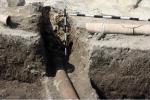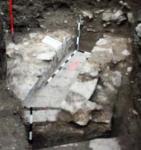Summary (English)
AQUAE CALIDAE – THERMA (DimchoMomchilov – karnobat.muzey@mail.bg, Miroslav Klasnakov) In Sector East, an area to the east of the eastern wing of the thermae of the 4th century AD was explored. Strata up to 60 cm thick were documented, containing Thracian sherds of the 8th – 7th centuries BC and Greek black-gloss pottery of the 4th century BC. Wooden posts were driven trough these strata and the eastern wing of the thermae was built over the posts. A water-conduit No. 4 of terracotta pipes was discovered. Sherds and 15 coins of the 4th century AD and a republican denarius of 134 BC were found. In Sector South, the extension of the drain of the pool was discovered to the east of the Ottoman baths which were built over the central part of the Roman and Byzantine thermae. Mediaeval coins, sherds from sgraffito pottery and a Byzantine lead seal showing St. Pantaleimon of the 11th century were found. Base No. 2 was discovered in Trench A1, 1.50 m by 1.50 m in size and 65 – 70 cm in height, built of cut and uneven stones bonded with mortar. It was identical to Base No. 1 discovered in the apodyterium. Remains from a collapsed roof and a fire were documented: traces from fire, fragmentary tegulae, sherds and coins of the 4th century AD were found in a layer 40 – 50 cm thick. A Late Antique house dug into the stratum of the Roman period was partly explored to the southeast of Base No. 2. Sherds and coins of the 4th century AD were found. A wall built in opus mixtum belonging to the thermae of the 4th century AD was discovered. The floor in the central building of the thermae was paved with slabs and part of a drain was discovered beneath. Buildings of the Early Byzantine period built in rubble masonry and two ovens were discovered to the west of the thermae. The finds included several sherds of the 2nd – 4th centuries AD, sherds of the 5th – 7th centuries AD, a bone comb, finger-rings, pieces of iron slag and 60 coins of the 4th century AD, the 6th century AD and the 11th – 12th centuries.
- Dimcho Momchilov - Museum of History – Karnobat
- Miroslav Klasnakov - Regional Museum – Burgas
Director
Team
Research Body
- Museum of History – Karnobat
- Regional Museum – Burgas






![Download [PDF]](/excavation/skins/fasti/images/results/download_sml.png)

